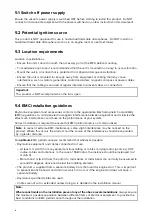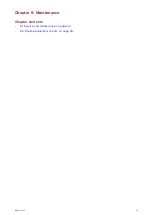
7.1 General cabling guidance
Cable types and length
It is important to use cables of the appropriate type and length.
• Unless otherwise stated only use cables supplied by Raymarine.
• Where it is necessary to use non-Raymarine cables, ensure that they are of correct quality and
gauge for their intended purpose. (e.g.: longer power cable runs may require larger wire gauges to
minimize voltage drop along the run).
Cable routing
Cables must be routed correctly, to maximize performance and prolong cable life.
• Do NOT bend cables excessively. Wherever possible, ensure a minimum bend diameter (Ø) of
200 mm (7.87 in) / minimum bend radius (R) of 100 mm (3.94 in).
• Protect all cables from physical damage and exposure to heat. Use trunking or conduit where
possible. Do NOT run cables through bilges or doorways, or close to moving or hot objects.
• Secure cables in place using cable clips or cable ties. Coil any excess cable and tie it out of the way.
• Where a cable passes through an exposed bulkhead or deckhead, use a suitable watertight
feed-through.
• Do NOT run cables near to engines or fluorescent lights.
• Always route data cables as far away as possible from:
– other equipment and cables,
– high current carrying AC and DC power lines,
– antennas.
Strain relief
Use adequate strain relief for cabling to ensure that connectors are protected from strain and will not
pull out under extreme sea conditions.
Cable shielding
Ensure that cable shielding is not damaged during installation and that all cables are properly
shielded.
24
Summary of Contents for RCR-1
Page 2: ......
Page 4: ......
Page 10: ...10...
Page 13: ...Chapter 3 Parts supplied Chapter contents 3 1 Parts supplied on page 14 Parts supplied 13...
Page 16: ...4 1 Product dimensions 29 mm 1 14 in diameter cut out hole required 16...
Page 22: ...22...
Page 28: ...28...
Page 32: ...32...
Page 38: ...38...
Page 41: ......
Page 42: ......
Page 44: ......
Page 45: ......
















































